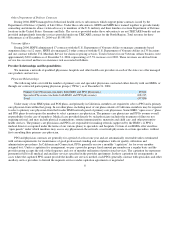Health Net 2004 Annual Report Download - page 21
Download and view the complete annual report
Please find page 21 of the 2004 Health Net annual report below. You can navigate through the pages in the report by either clicking on the pages listed below, or by using the keyword search tool below to find specific information within the annual report.
deemed to be forward-looking statements. Without limiting the foregoing, the words “believes,” “anticipates,” “plans,” “expects,”
“may,” “should,” “could,” “estimate” and “intend” and other similar expressions are intended to identify forward-looking statements.
Managed health care companies operate in a highly competitive, constantly changing environment that is significantly influenced by,
among other things, aggressive marketing and pricing practices of competitors and regulatory oversight. Factors that could cause our
actual results to differ materially from those reflected in forward-looking statements include, but are not limited to, the factors set
forth below and the risks discussed in our other filings from time to time with the SEC.
We wish to caution readers that these factors, among others, could cause our actual financial or enrollment results to differ
materially from those expressed in any projections, estimates or forward-looking statements relating to us. In addition, those factors
should be considered in conjunction with any discussion of operations or results by us or our representatives, including any forward-
looking discussion, as well as comments contained in press releases, presentations to securities analysts or investors or other
communications by us. You should not place undue reliance on any forward-looking statements, which reflect management’s
analysis, judgment, belief or expectation only as of the date thereof. Except as may be required by law, we undertake no obligation to
publicly update or revise any forward-looking statements to reflect events or circumstances that arise after the date of this Annual
Report.
Our profitability will depend, in part, on our ability to accurately predict and control health care costs.
A substantial majority of the revenue we receive is used to pay the costs of health care services or supplies delivered to our
members. The total health care costs we incur are affected by the number and type of individual services provided and the cost of
each service. Our future profitability will depend, in part, on our ability to accurately predict health care costs and to control future
health care costs through underwriting criteria, utilization management, product design and negotiation of favorable professional and
hospital contracts. Changes in utilization rates, demographic characteristics, the regulatory environment, health care practices,
inflation, new technologies, clusters of high-cost cases, continued consolidation of physician, hospital and other provider groups and
numerous other factors affecting health care costs may adversely affect our ability to predict and control health care costs as well as
our financial condition, results of operations and cash flows. Periodic renegotiations of hospital and other provider contracts, coupled
with continued consolidation of physician, hospital and other provider groups, may result in increased health care costs or limit our
ability to negotiate favorable rates.
One of the fastest increasing categories of our health care costs is the cost of hospital-based products and services. As such, in
addition to the circumstances and factors that may limit our ability to fully base premiums on estimated costs, our HMOs face an even
higher risk with hospital expenses that could have a material adverse effect. Factors underlying the increase in hospital costs include,
but are not limited to, the underfunding of public programs, such as Medicaid and Medicare, growing rates of uninsured individuals,
new technology, state initiated mandates, alleged abuse of hospital chargemasters, an aging population and, under certain
circumstances, relatively low levels of hospital competition. In 2004, several of our health plans experienced higher than expected
claims costs, especially for inpatient and outpatient hospital claims. These higher than expected costs caused our consolidated results
of operations to fall short of expectations in 2004 as realized premium yields were lower than cost trends. In an effort to account for
these higher cost trends, we instituted higher premium pricing in our California and Northeast health plans and increased reserves in
the fourth quarter of 2004.
Another significant category of our health care costs are costs of pharmaceutical products and services. Although pharmaceutical
costs have not been increasing at the level of hospital costs, evolving regulation may impact the ability of our HMOs to continue to
receive existing price discounts on pharmaceutical products for our members. Other factors affecting our pharmaceutical costs
include, but are not limited to, the price of drugs, utilization of new and existing drugs and changes in discounts. The inability to
forecast and manage our health care costs could have a material adverse effect on our financial condition and results of operations.
18
























